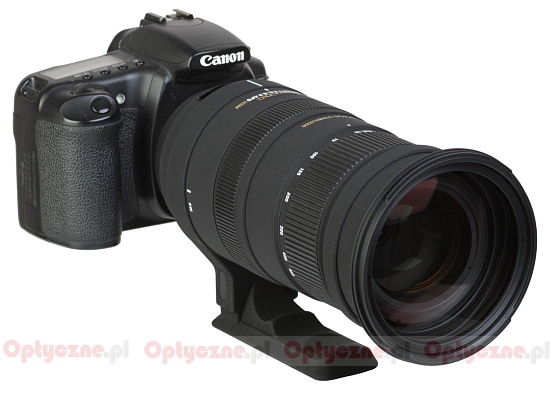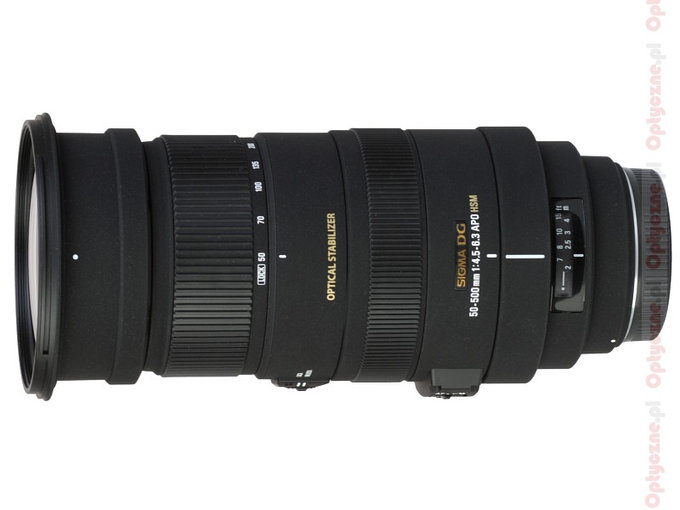Sigma 50-500 mm f/4.5-6.3 APO DG OS HSM
1. Introduction
The 50-500 mm f/4-6.3 DG EX APO RF HSM model, commonly known also as ”Bigma”, was one of more interesting lenses in the Sigma line-up. It was a real sensation on the market as no other manufacturer has offered so far a lens with 10x high zoom ratio which ends at 500 mm focal length to boot. What’s more, although it is difficult to get good optical properties with such parameters, many users have expressed positive opinions about this lens, indicating that the Sigma managed to accomplish that feat.
We lacked the opportunity to publish the full test of that lens but it doesn’t mean we didn’t have it in our hands. The Sigma 50–500 mm f/4–6.3 DG EX APO RF HSM found its way to our editorial office about three years ago and its full test was dully performed then. The preliminary results’ analysis, however, indicated that the picture quality decreased very quickly with the increase of the focal length. In our opinion such a decrease was a bit too sharp, especially when compared to the results we got in field conditions pictures. I suspected that a tripod might be responsible for it. As it happened right at the beginning of the Optyczne.pl activity, there was only a Manfrotto 055PRO model with a 410 geared head at our disposal. I was afraid that device was not stable enough to support the heavy Sigma lens, set at 500 mm. I decided to postpone the publication of the test results until we would get a chance to check them on a more solid tripod. After several months, our editorial office acquired a Gitzo GT5530S with a far greater load capacity, being able to support equipment weighing even more than a dozen kilograms, but, unfortunately, due to the lack of time the old Bigma’s test hasn’t been updated anyway.
Please Support UsIf you enjoy our reviews and articles, and you want us to continue our work please, support our website by donating through PayPal. The funds are going to be used for paying our editorial team, renting servers, and equipping our testing studio; only that way we will be able to continue providing you interesting content for free. |
- - - - - - - - - - - - - - - - - - - - - - - - - - - - - - - - - - - - - - - - - - - - - - - -
Although my impressions of the old Bigma’s performance were positive, it was also evident that the lens desperately needed an optical stabilization system or a very solid tripod. If you wanted to take photos at 400-500 mm focal length without using any support and to get optimal picture quality on stopping down just slightly, you would need either beautiful, sunny weather and plenty of open space or an ISO speed of 800-1600 or even faster.
When in February 2010 Sigma announced the launch of a successor of the Bigma, equipped with image stabilization, I was very glad and doubly so. Firstly, because of that stabilization system. Secondly, because of the outstanding test, which has been nagging me somewhere deep in my brain lobes ever since. A swift testing of the new model will certainly make my pricks of conscience less painful.
The first specimen of the new Sigma 50–500 mm f/4.5–6.3 APO DG OS HSM, which was imported by the K-Consult company, the Polish distributor of Sigma products, was in a Canon mount. As it was a novelty on the market and we didn’t want to put the test off any longer, we decided to conduct it on our Canon EOS 50D body. Borrowing a full frame EOS 1Ds MkIII would mean a significant delay in publishing the results and we wanted to avoid it. Apart from that, it seems that the new Bigma will be used on bodies with APS-C/DX sensors more often than on full frame anyway.
Information about our review method can be read in our article “How do we test lenses?"
 |







